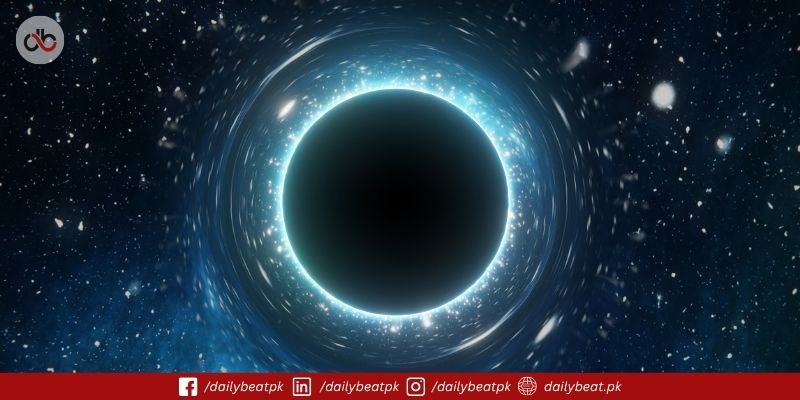What Is a Free-Floating Black Hole?
A free-floating black hole is a type of black hole that drifts through space, unanchored to any galaxy. Unlike the supermassive giants that sit at galactic centers, these black holes roam freely, often hidden and hard to detect. They don’t emit much light unless something crosses their path, and when that happens, the universe puts on a show.
Unlike most black holes formed by collapsed stars or galaxy collisions, a free-floating black hole in space could be the leftover core of a shattered galaxy or a remnant from the early universe. Since they move independently and are usually invisible, scientists often discover them only when they interact with nearby stars or gas.
A Black Hole Caught in the Act
Astronomers recently spotted what might be one of the rarest cosmic events ever witnessed: a free-floating black hole actively feeding on a star.
Using NASA’s Hubble Space Telescope and the Chandra X-ray Observatory, researchers zeroed in on an object named NGC 6099 HLX-1, located in the outskirts of a distant galaxy in the Hercules constellation, about 450 million light-years from Earth.
The object, likely an intermediate-mass black hole (IMBH), is estimated to lie within a dense star cluster nearly 40,000 light-years from the galaxy’s core. It isn’t sitting at the center like most black holes, it’s wandering and appears to be snacking on a nearby star. This feeding frenzy is referred to by scientists as a black hole feeding event, specifically a tidal disruption event.
Why This NASA Black Hole Observation Matters
The NASA black hole observation of HLX-1 offers more than just an exciting space story. It helps fill in a cosmic gap. Most known black holes are either:
- Stellar-mass black holes (under 100 times the mass of the Sun), or
- Supermassive black holes (millions or billions of times more massive).
But the intermediate-mass black hole class sits between them and has remained incredibly elusive, until now.
The bright X-ray flare observed in 2009, with a peak in 2012, strongly suggests that HLX-1 swallowed material from a nearby star. This act created a disk of plasma around the black hole that glowed at 3 million degrees Fahrenheit, making it visible to Earth-based instruments.
The flare’s gradual rise and fall add more credibility to this being a black hole feeding event, rather than just random cosmic noise.
Packed With Stars, Packed With Possibilities
NASA’s Hubble observations revealed that HLX-1 is surrounded by a dense cluster of stars, some separated by just a few light-months, roughly 500 billion miles. This packed star field offers a rich buffet for any nearby black hole.
In such environments, the chances of a star wandering too close and being torn apart increase dramatically. That’s likely what happened here, and it’s what made the black hole visible for the first time.
Lead scientist Yi-Chi Chang noted that these types of extremely bright X-ray sources are rare outside the centers of galaxies. When they are found, they can serve as cosmic breadcrumbs leading researchers to intermediate-mass black holes, a missing link in the story of black hole evolution.
What Makes Intermediate-Mass Black Holes Special?
Understanding intermediate-mass black holes is key to solving one of the biggest mysteries in astrophysics: How do galaxies grow?
One theory suggests that when small galaxies merge, their central black holes also merge, forming bigger black holes over time. Eventually, this builds up to the supermassive black holes we find in the heart of modern galaxies.
Another theory says that in the early universe, clouds of gas collapsed directly into massive black holes, skipping the star phase entirely. That idea gained traction after the James Webb Space Telescope found black holes in small, young galaxies that seem too large for their surroundings.
So, the more free-floating black holes NASA can find and study, the better we can understand which theory, or mix of both, is closer to the truth.
New Telescopes Could Unlock More Secrets
Finding these elusive objects isn’t easy. Telescopes like Chandra and ESA’s XMM-Newton only observe a small section of the sky at a time. This limits the chances of catching a black hole feeding event in real-time.
But help is on the way.
The upcoming Vera C. Rubin Observatory in Chile will scan the entire sky regularly in optical light, which could help detect more sudden flares caused by free-floating black holes. Once detected, NASA’s space telescopes like Hubble and Webb can then zoom in for a closer look.
According to astrophysicist Roberto Soria, “If we are lucky, we’ll find more of these black holes lighting up suddenly. A statistical study of such events can finally reveal how many of these black holes exist, and how galaxies have evolved.”
Final Thoughts: Why This Matters for Earthlings
Though free-floating black holes in space seem far removed from life on Earth, studying them changes how we understand our place in the universe.
These cosmic giants play a central role in galaxy formation, stellar death, and even time itself. Each time astronomers catch one in action, like in the case of HLX-1, they unlock another chapter in the universe’s story.
As new observatories come online and more discoveries roll in, these once-hidden travelers may finally come out of the dark.
For more mind-blowing cosmic reveals, check out the Fantastic Four Marvel movie cast and plot details.















